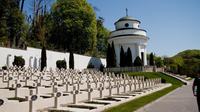Private City Tour of Lychakiv Cemetery
Lviv, Ukraine
Trip Type: Cultural Tours
Duration: 3 hours
Lychakiv Cemetery, officially State History and Culture Museum-Preserve Lychakiv Cemetery, is a famous and historic cemetery in Lviv Ukraine. Since its creation in 1787 as Łyczakowski Cemetery, it has been the main necropolis of the city's intelligentsia, middle and upper classes.
More About This Activity All Cultural Tours →
Lychakiv Cemetery, officially State History and Culture Museum-Preserve Lychakiv Cemetery, is a famous and historic cemetery in Lviv Ukraine. Since its creation in 1787 as Łyczakowski Cemetery, it has been the main necropolis of the city's intelligentsia, middle and upper classes.
Initially the cemetery was located on several hills in the borough of Lychakiv, following the imperial Austro-Hungarian edict ordering that all cemeteries be moved outside of the city limits. The original project was prepared by Karol Bauer, the head of the Lviv University botanical garden. The Cemetery consist of: Field of Mars, NKVD victims' graves (1941 y.), Outstanding Poles Pantheon, The eldest graves, Main gates, 1863 January rebels' quarter, 1830−1831 November rebels' quarter, Ukrainian National Army Memorial, Lviv Defenders' Cemetery (Cemetery of Lwów Eaglets).
Cemeteries are linked in a complicated manner with the political, social and cultural life of people. You will admire Chapels of Boims and Kampians – gems of Renaissance architecture, the memorial Lychakiv Cemetery with a set of unique monuments of 18th – 20th centuries, the Graveyards of Polish insurgents of 1831 and 1863, of soldiers of the Polish – Ukrainian War of 1918 – 1919 and of the Second World War.
Ukrainian poet, writer, social and literary critic, journalist, economist, and political activist Ivan Franko. His grave has a stone character from one of his revolutionary poems – a miner with a pick hitting a rock. Across from Ivan Franko is the grave of the well-known Ukrainian composer Stanislaw Liudkevych. The grave of another big name in music, the world famous Ukrainian opera singer of the early 20th century Solomiya Krushelnytska after whom the Lviv Opera House is now named.
Initially the cemetery was located on several hills in the borough of Lychakiv, following the imperial Austro-Hungarian edict ordering that all cemeteries be moved outside of the city limits. The original project was prepared by Karol Bauer, the head of the Lviv University botanical garden. The Cemetery consist of: Field of Mars, NKVD victims' graves (1941 y.), Outstanding Poles Pantheon, The eldest graves, Main gates, 1863 January rebels' quarter, 1830−1831 November rebels' quarter, Ukrainian National Army Memorial, Lviv Defenders' Cemetery (Cemetery of Lwów Eaglets).
Cemeteries are linked in a complicated manner with the political, social and cultural life of people. You will admire Chapels of Boims and Kampians – gems of Renaissance architecture, the memorial Lychakiv Cemetery with a set of unique monuments of 18th – 20th centuries, the Graveyards of Polish insurgents of 1831 and 1863, of soldiers of the Polish – Ukrainian War of 1918 – 1919 and of the Second World War.
Ukrainian poet, writer, social and literary critic, journalist, economist, and political activist Ivan Franko. His grave has a stone character from one of his revolutionary poems – a miner with a pick hitting a rock. Across from Ivan Franko is the grave of the well-known Ukrainian composer Stanislaw Liudkevych. The grave of another big name in music, the world famous Ukrainian opera singer of the early 20th century Solomiya Krushelnytska after whom the Lviv Opera House is now named.
« Go Back

